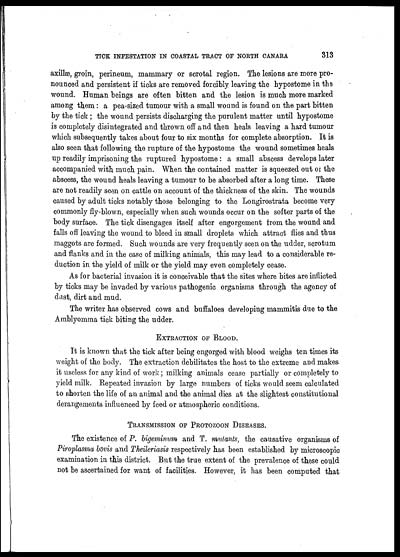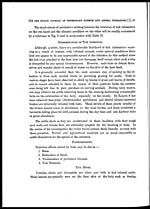Medicine - Veterinary > Veterinary colleges and laboratories > Indian journal of veterinary science and animal husbandry > Volume 1, 1931 > Part IV (December 1931) > Tick infestation in the coastal tract of North Canara district
(360) Page 313
Download files
Individual page:
Thumbnail gallery: Grid view | List view

TICK INFESTATION IN COASTAL TRACT OF NORTH CANARA 313
axillæ, groin, perineum, mammary or scrotal region. The lesions are more pro-
nounced and persistent if ticks are removed forcibly leaving the hypostome in the
wound. Human beings are often bitten and the lesion is much more marked
among them: a pea-sized tumour with a small wound is found on the part bitten
b y the tick ; the wound persists discharging the purulent matter until hypostome
is completely disintegrated and thrown off and then heals leaving a hard tumour
which subsequently takes about four to six months for complete absorption. It is
also seen that following the rupture of the hypostome the wound sometimes heals
up readily imprisoning the ruptured hypostome : a small abscess develops later
accompanied with much pain. When the contained matter is squeezed out or the
abscess, the wound heals leaving a tumour to be absorbed after a long time. These
are not readily seen on cattle on account of the thickness of the skin. The wounds
caused by adult ticks notably those belonging to the Longirostrata become very
commonly fly-blown, especially when such wounds occur on the softer parts of the
body surface. The tick disengages itself after engorgement from the wound and
falls off leaving the wound to bleed in small droplets which attract flies and thus
maggots are formed. Such wounds are very frequently seen on the udder, scrotum
and flanks and in the case of milking animals, this may lead to a considerable re-
duction in the yield of milk or the yield may even completely cease.
As for bacterial invasion it is conceivable that the sites where bites are inflicted
by ticks may be invaded by various pathogenic organisms through the agency of
dust, dirt and mud.
The writer has observed cows and buffaloes developing mammitis due to the
Amblyomma tick biting the udder.
EXTRACTION OF BLOOD.
It is known that the tick after being engorged with blood weighs ten times its
weight of the body. The extraction debilitates the host to the extreme and makes
it useless for any kind of work ; milking animals cease partially or completely to
yield milk. Repeated invasion by large numbers of ticks would seem calculated
to shorten the life of an animal and the animal dies at the slightest constitutional
derangements influenced by feed or atmospheric conditions.
TRANSMISSION OF PROTOZOON DISEASES.
The existence of P. bigeminum and T. mutants, the causative organisms of
Piroplasma bovis and Theileriasis respectively has been established by microscopic
examination in this district. But the true extent of the prevalence of these could
not be ascertained for want of facilities. However, it has been computed that
Set display mode to: Large image | Zoom image | Transcription
Images and transcriptions on this page, including medium image downloads, may be used under the Creative Commons Attribution 4.0 International Licence unless otherwise stated. ![]()
| Permanent URL | https://digital.nls.uk/75226875 |
|---|
| Description | Covers articles from 1931. |
|---|




